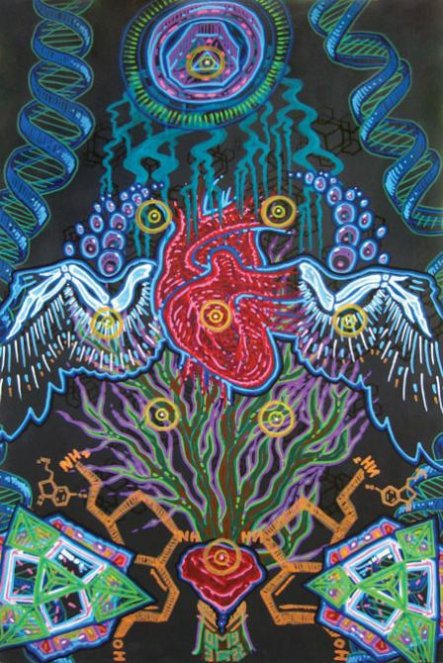This article originally appeared in H+ Magazine.
One hundred and fifty years ago, paleontologist Thomas Henry Huxley (an autodidact and philosopher who coined the term “agnostic” and was known as “Darwin’s Bulldog” for his passionate defense of natural selection) asserted that humankind would eventually take the processes of evolution into our own hands. Within a few decades of his proclamation, a cadre of equally brilliant scientists including Werner Heisenberg, David Bohm, and Max Planck began to unravel the mysterious properties of quantum mechanics. These two theories — evolutionary and quantum dynamics — can each be considered among the most important discoveries of all time. Taken together, they have changed almost everything about the way we understand reality. However, in spite of the popularity of interdisciplinary research and unifying theories over the last hundred years (despite, even, quantum physicist Erwin Schröedinger’s 1944 book, What Is Life?), it was only recently that the relationship between these two vastly important domains was even considered. Now, a new kind of science, called “quantum biology,” is beginning to emerge — and it could change everything we know, again.
The premise is simple. Life is a molecular process; molecular processes operate according to the quantum playbook; therefore, life is a quantum process. And yet, it wasn’t until the nineties that anyone suggested biology could be better understood by looking at it through the lens of quantum theory. (The seminal paper was D.V. Nanopoulos’ "Theory of brain function, quantum mechanics and superstrings.”) Not long after that, the idea caught on — particularly in the neurosciences, where the idea of the brain as a quantum computer quickly became a topic of fierce debate.
Quantum computation, a science still in its infancy, promises swiftness and efficiency vastly superior to anything possible with conventional silicon chips. Rather than relying on binary bits like contemporary systems, quantum computers use “qubits” that include all possible superpositions of a particle’s classical state. Instead of being “trapped” in a single configuration, the logic gates of a quantum computer employ multiple possibilities in synchrony — using the entire set of alternative outcomes to arrive at an answer.
It’s a promising avenue for people with big plans for strong AI or virtual reality. The only complication is that coherence — in which the many possible states of a particle or group of particles stay hung in superposition — is something scientists have only been able to study under extremely controlled conditions. It’s only possible when that system doesn’t interact with anything else that might “collapse the wave function,” and so most of the major options for quantum computing involve impractical scenarios like creating a supercooled vacuum.
This is one of the reasons that many scientists have considered quantum biology both unlikely and unscientific. The thermal noise of biological systems seemed too great to allow for quantum weirdness; and even if it could, how on Earth would we study it? But science is the story of ingenuity’s victory over shortsightedness — and one research team, led by Gregory S. Engel at UC Berkeley, has devised a way to directly detect and observe quantum-level processes within a cell using high-speed lasers.
They were trying to establish exactly how organic photosynthesis approaches 95% efficiency, whereas the most sophisticated human solar cells operate at only half that. What they discovered is nothing short of remarkable. Using femtosecond lasers to follow the movement of light energy through a photosynthetic bacterial cell, Engel et al. observed the energy traveling along every possible direction at the same time. Instead of following a single trajectory like the electrons on a silicon chip, the energy in photosynthesis explores all of its options and collapses the quantum process only after the fact, retroactively “deciding” upon the most efficient pathway.
What does this all mean? Not only do quantum phenomena occur in living systems, but the basic processes of life we take for granted rely on the transfer of information backward in time. Life is so magical because it cheats.
Although the mechanisms by which a living cell can prevent decoherence by dampening its own chemical “noise” remain utterly mysterious, findings such as Engel's conclusively demonstrate that room-temperature quantum computing is possible (and knowing how something works isn’t always necessary in order to use it). And Engel’s group isn’t the only team to detect it: other laboratories have implicated a phenomenon called electron tunneling (micro-teleportation, in which an electron disappears in one location and instantaneously appears somewhere else without having traveled the intermediate distance) at work behind a range of organic phenomena, from our sense of smell and the activities of our enzymes to the neutralization of free radicals with anti-oxidants… possibly even consciousness itself. Paul Davies (Arizona State University) and JohnJoe McFadden (The University of Surrey) have independently suggested that computation in the netherworld of quantum coherence might explain how the earliest self-replicating molecules overcame the inestimable odds against them — life’s very existence may be the consequence and continued operation of a quantum computer. We may ultimately have to accept our human quest for qubit calculation as a kind of biomimicry, rather than something new and unique.
Quantum biology stands to answer other big questions, as well — questions that many contemporary biologists prefer to ignore. McFadden, in his excellent primer Quantum Evolution, cites several experiments that suggest certain mutations are “intelligent,” even “anticipatory.” For example, bacterial cultures have been observed to evolve clever responses to lab toxins at speeds that — just like the emergence of DNA from a primordial soup — defy astronomical odds. Can biological quantum calculation account for this? McFadden thinks so. (His hypothesis was itself anticipated in the science fiction of Greg Egan, whose novel Teranesia featured some very “spooky” retrocausal mutations — including the instantaneous appearance of entire new ecosystems via competing future evolutionary scenarios. Whether such extreme examples of quantum biological principles are possible remains to be seen.)
As we continue to probe biological phenomena that beat quantum computer scientists to the punch, a new picture emerges of evolutionary computing and design. Huxley’s prophecy that we will eventually take the reins of our own evolution might come true sooner than predicted by establishment geneticists. But by appealing to the quantum oracle, we may be acting in service of something far older and more intelligent than we can even guess. Ultrafast computing, accelerated by our explorations into the new science of quantum biology, could well be the critical technology that pushes us over the edge into the Singularity — a timeless and transcendent event in which we already live, because it is the nature of life itself — a vast sentience beyond human comprehension, and we are merely the newest avenue for its expression in the world. Classical or quantum, human or ecological, natural selection still gets the last laugh.
Article image: "Just Another Desert Party" by Michael Garfield














